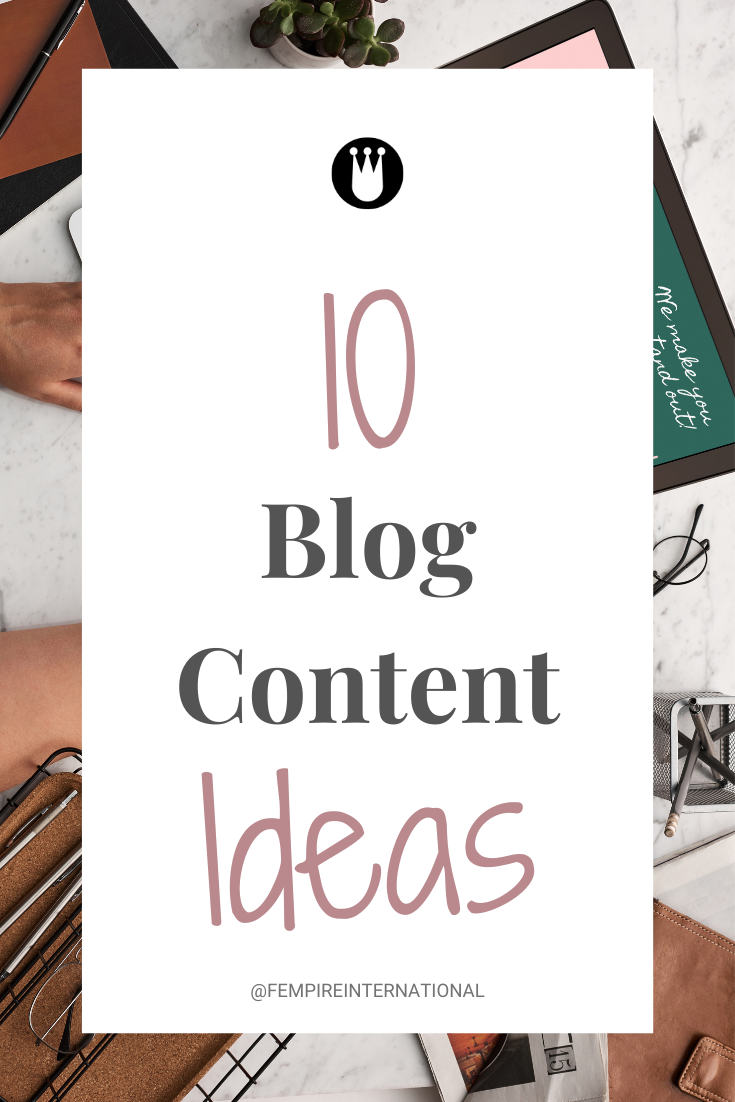So you’ve decided to start your blog. How exciting!
Whether writing is your thing or not, blogs are an important part of many businesses. And there are a few key elements that separate an ordinary, average blog from a traffic driving, content producing, trending super machine!
But before you start frantically typing….

….you need to make sure you have done your research, and have a plan in place.
Your blog will do a lot for your business, which is why it’s a great idea to have one. And I am here to break down blog creation into some very simple steps so that your blog will do what it should for your business.
The Benefits of Business Blogging
First, let’s talk about exactly how having a blog can help grow your business into a Fempire.
Drives Traffic to your Website
Having a blog boosts your search engine optimisation (SEO), and this is something you can do pretty easily and for free. You may have heard that SEO results are complex to master, and this is true. But put in the work and you won’t regret it – new content and the right keywords will certainly help you stand out.
Traffic means Leads
Getting people to your website to read your blog means opportunity. It gives you the chance to get their contact information so that you can develop a deeper relationship with them – you never know, one day they may be your biggest customer.
Become an Industry Expert
If you are in business that means you are good at something. You obviously have skills and passion and want to share that with the world. Showing off your knowledge helps people trust that you know what you are doing, and that you won’t waste their time and money with your products and services.
Look after your Customers
These days if you think that business is just about selling to one customer and then moving onto the next – you are selling yourself short. Customers are looking for more than just a product or service. We are in the age of experience. Provide customers with an amazing experience from the time they first discover you to well after they have purchased from you. Make it excellent for them and you will have your most effective marketing machine – a raving fan.
Make it excellent for them and you will have your most effective marketing machine – a raving fan.
A blog is a great way to inform and educate your customers. It maintains communication between you and your customers through your website. You might even consider using a customer to write a case study. It could also be useful for some businesses to write a customer service or support blog.
Boost your Social Media Presence
Blogs are the ultimate content multiplier. A Content Multiplier is a piece of content, such as a blog, that can be broken down into smaller high value pieces of content for use across a selection of platforms. For example using an image, a quote, a list or a paragraph from your blog and repurposing it as a post across Facebook, Instagram, and Twitter.
One blog post can produce over 30 pieces of content for your social media channels, helping you fill up your content calendar without you having to produce additional work. You don’t have to sit there wondering what to post next – your blog will do a lot of the work for you.
One blog post can produce over 30 pieces of content for your social media channels, helping you fill up your content calendar without you having to produce additional work. #bloggingforbusiness Share on XPlay for the Long Game
We have all heard about being selective in posting on social media because once it’s out there – it’s out there! Let’s flip the connotations of that statement. Once your blog is out there – it stays out there, working for your business indefinitely, doing all the things I mentioned above – and all for free. You won’t get market leverage like that doing anything else.
Now that you understand why you need a blog – how do you write one that will do what you need it to do?
Whether you are brimming with ideas or scratching your head, there’s no reason to wait – you can start your blog journey today.
My Top 10 Content Ideas
If you are wondering what to write – here are my 10 Top Ideas to get the wheels and cogs turning.
- Solve a Problem
Think about the common problems your clients have that your product or service solves – and write about it. This shows that you really understand your customer.
- Write your Story
People want to get to know you. They want to know that you understand them and that you have experienced problems yourself or helped others solve their own problems. - Conduct Interviews
Interview someone your readers would be interested in. This could be anyone from a special client, to an industry expert, or a celebrity (that is if you have access to one). - Share your Knowledge
What don’t people know about your product or service that they should? This could include handy ways to use your products, hidden benefits of your service or things they need to consider when shopping around. This is a great chance to flex your unique selling proposition (what makes you special and different from your competitors). - Share your Opinions
Curate a list of quotes, content, tutorials or other blogs that are the best of the best and explain why you think they are important to your readers. - Experiences
Write about an experience you have had in your business where you helped someone achieve great results (get their permission to use their name and photo if possible, otherwise you’ll have to make them anonymous and your story won’t be as credible). - Share your Vision
Explain why your vision and mission statement are what they are. - Common Misconceptions
Discuss old wives tales. What are some of the common misconceptions about your industry/products/services? - Tips & Tricks
What are the tips and tricks in your niche that people don’t know about? - Share your Business Story
Write about your business – how it started, where it is now, where you are taking it in the next year.
With your mind now flowing – let’s get down to research. That’s right, it’s not quite time to start writing just yet.
Do Your Research
Say it with me.. PLANNING.
Before you get started, you need to plan your blog. Download my Blog Planning Template and let me guide you through the process.
You need to understand the key elements that make up a blog before you start writing.
Headlines
So, you have an idea, now go and write two amazing headlines for your blog.
Why two you ask?
These are the first two of your content multipliers for social media. There is an art to writing a headline that will capture the attention your blog needs. Read Marnie’s article: 12 Ways to Generate Profit with Headlines to learn how to write compelling headlines! And if you’re still stuck on ideas, you can download Fempire’s free guide to creating irresistible headlines!

Another tool to try is CoSchedule’s Headline Analyzer. Use it to compare and test out your high converting headlines.
Keywords
Keyword research can be daunting, but don’t worry, there are tools for that too. A great tool is the Wordstream Keyword Tool. Another option is Keyword Surfer. This is a chrome extension that gives you great information every time you do a google search using chrome. Think of what you would google if you were looking for the product or service you offer and Keyword Surfer will give you a list of keyword ideas.
Hook
You only have 4 seconds to grab people’s attention, so you need a hook. It is your chance to entice readers with one or two sentences that makes them want to keep reading. Your hook is another example of a content multiplier.
Body
Most people just skim over things these days. We are in constant information overload and you need to stand out from the noise. Creating subheadings in the body of your blog is another way to encourage your readers to keep reading. Take a look at a newspaper. See how it is set out with multiple headlines all screaming for you to pay attention? Alternately you can include dot points or use a numbered format to make the content easier to skim through and digest.
I’ve used both formats in this blog – and you want the same for your blog.
Do you think someone that is scrolling through their phone or tablet on the train to work wants to read a long document that is just paragraph after paragraph without any visual interest? Do you think they really want to read every word because there is every chance the information they are looking for might not be in your article? Make it easy for them and highlight the important parts!
Internal Links
Now moving back to SEO. You want your blog to be a part of the larger information network – this means links. Internal links are a way of explaining to Google that the pages on your website are valuable, relevant, and relate to each other. It helps Google notice your blog and if Google notices, it will boost your ranking.
Don’t forget about your older blog content. Any other blog posts you have written that are related to your topic can be linked within your blog so that there are linked references throughout your own content. Alternatively, give yourself a shout out at the end, such as – “If you liked my article you can find more of my work here”.
And if you are just starting out, you can always come back to your blog at a later date and add internals links in when you have them.
External Links
The golden rule of using other people’s work is making sure you give them the credit they deserve. Using external or outbound links is also a great opportunity to show that you have done your research. Just remember, if you want to be taken seriously make sure your sources are credible and respectable. This demonstrates your authority in the field (because you are up to date with industry thought leaders) and people will trust you to bring them the information they need.
The golden rule of using other people’s work is making sure you give them the credit they deserve.
Don’t believe me? Read the article: How Outbound Link Improves Your SEO – External link SEO Benefits by Harsh Agrawal!
Quotes
Depending on what audience you are writing for, a quote from a celebrity or professional can provide readers with the chance to reflect on what you are saying, they break up your text and it gives a bit of spice and variety to your work – it is also another way to get an external links into your blog when required.
Everyone has a transferable commodity – knowledge. Sharing your unique expertise and making introductions for someone creates a lasting legacy.
Marsha Blackburn
Graphics
The right images and graphics can be do or die for your blog. You can write the most amazing piece, but if you don’t give people any eye candy, they may well skim over your masterpiece all together. Give your readers something eye-catching to draw them in. Graphics and images can say what words can’t sometimes and are a key ingredient for every blog. You can use your own images but they have to be great quality.
If you don’t have your own images, use sites like Unsplash, Pixabay and Pexels as they have great stock images for you to use in your blog for free (if you can give a shout out to the photographer, that would be nice).

Your blog may need more than just some pretty pictures. You may need something like an infographic. You can create an endless list of graphics in Canva – and you don’t need to be creative, a designer, an artist, or even very experienced to do this. Canva has a massive range of templates for you to use for free. This is your content multiplier again – share these graphics on your social platforms.

Tweets
Select statements in your blog that will stand out to you as great Tweets to drive traffic back to your website, if you have a Twitter account. With most blogging platforms, you can add these to your blogs as ‘tweetables‘, so that your readers simply have to click on them and the tweet, along with a link to your article will be opened up in a new tab, so all they have to do is click ‘tweet’.
Try it out on the tweetable below!
Once your blog is out there – it stays out there, working for your business indefinitely, driving traffic to your website, boosting your engagement, and establishing you as an industry expert – and all for free. #ladyboss Share on XSummary
Some readers might just skip to the summary, or see the summary on google (with a thumbnail of one of your images). This is your last chance to grab them. Summarise the main points of your blog so people know what they are getting into.
Call to Action
The last and most crucial element to pulling this all together is making sure you have a call to action. Tell your readers what to do next. Ideally, you want them to give you their contact information (email address at a minimum) so that you can stay in touch and create a relationship with them as your next potential customer.
You can do this by offering them a freebie that they just have to have – after all it’s free. This is your lead magnet – in other words it attracts leads for your business. If you don’t have a lead magnet you can invite them to comment on your blog, share your blog or follow/like you on social media. You have their attention, don’t waste the opportunity to get them to engage with you.
Are you ready to start writing?
You can do it – I believe in you!
We have given you all the ingredients to whip up a blog that will supercharge the traffic to your website so your business can grow beyond your wildest dreams.
Put it all into action and let us know how you’re blog is going by leaving a comment below!
And if you enjoyed this article and want to stay updated on Fempire Magazine releases, sign up for our mailing list now!

This was written by one of our talented team members. Head to our About Fempire page to learn more about what Fempire does and how you can join the sisterhood. And don’t forget to follow us on Facebook, Instagram, LinkedIn, Youtube, or Pinterest by clicking the buttons below.





0 Comments